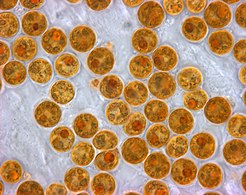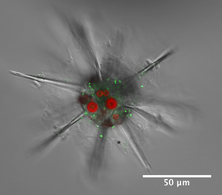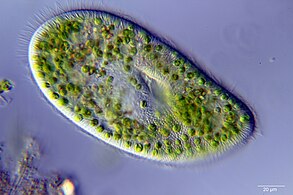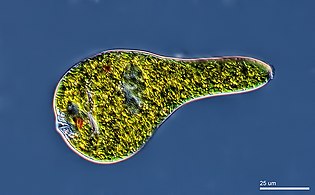混合营养生物
混合营养生物(英语:Mixotroph),是指在从完全自养的到完全异养的连续体上,混合使用不同的能量和碳源的生物,而非具有单一的营养模式。据估计,混合营养生物占所有微小浮游生物的一半以上。[1]真核生物混合营养生物有两种类型。有些拥有自己的叶绿体 - 包括内共生体提供的叶绿体。有些则是透过盗食质体(kleptoplasty)或与猎物的共生关系,或透过 “奴役 ”猎物的细胞器而获得它们。[2]
可能的组合有光养与化能、无机营养生物(Lithotroph)与有机营养生物(Organotroph)(渗透营养、吞噬营养与Myzocytosis)、自养(autotrophy) 与异养 (heterotrophy) 或其他组合。混合营养生物可以是真核生物或原核生物。[3]它们可以利用不同的环境条件。[4]
如果某种营养模式是必须的,那么它永远都是维持生长和维护的必要条件;如果是兼性的,则可以用来作为补充来源。[3]有些生物的卡尔文循环不完整,因此无法固定二氧化碳,必须使用有机碳来源。
概述
[编辑]生物体可以专性的或兼性的采用混合营养。
- 专性的混合营养:为了支持生长和维持,生物体必须同时利用异养和自养方式。
- 专性的自养与兼性的异养:仅自养足以生长与维持,但当自养能量不足时(例如,当光强度较低时),异养可作为补充策略。
- 兼性的自养和专性的异养:异养足以生长和维持,但自养可用于补充,例如,当猎物可用性非常低时。
- 兼性的混合营养:维持和生长可以单独透过异养或自养方式获得,并且混合营养仅在必要时使用。[5]
植物
[编辑]
在植物中,混合营养植物经典上适用于肉食性、半寄生性和真菌异养型的物种。然而,混合营养的特性可以扩展到更多的支系,因为研究显示氮和磷的有机形式,例如 DNA、蛋白质、氨基酸或碳水化合物,也是许多植物物种营养供应的一部分。[6]
动物
[编辑]与植物和微生物相比,混合营养动物较不常见,但有许多混合营养无脊椎动物的例子,也至少有一个混合营养脊椎动物的例子。
- 斑点钝口螈 (Ambystoma maculatum) 的细胞内也会寄生微藻。它的胚胎被发现有共生藻类生活在里面,[7] 这是脊椎动物细胞寄生内共生微生物的唯一已知例子 (除非考虑线粒体)。[8][9]
- 虫绿藻 (Zoolorella) 是归属于小球藻属 (Chlorella) 的绿藻属的一个保留名称。[10]术语“虫绿藻 Zoolorella”(复数“zoochlorellae”)有时用来指在淡水或海洋无脊椎动物或原生动物体内共生的任何绿藻。
- 造礁珊瑚(石珊瑚目)与其他许多刺胞动物门(如水母、海葵)一样,在细胞内寄生内共生微藻,因此成为混合营养动物。
- 东方胡蜂(Vespa orientalis)可从其表皮吸收的阳光中获取能量。[11] 因此,与此处列出的其他动物形成对比,这些动物在内共生体的帮助下属于混合营养动物。
-
黄海葵 Anthopleura xantogrammica 从虫绿藻 (Zoolorella) 中获得绿色。
-
微生物
[编辑]细菌和古菌
[编辑]- 副球菌属 (Paracoccus pantotrophus) 是一种可以化学有机异养生活的细菌,可以代谢多种有机化合物。兼性化学自养代谢也是可能的,如在无色硫细菌(一些硫杆状菌属)中所见,其中硫化合物如硫化氢、元素硫或硫代硫酸盐被氧化为硫酸盐。硫化合物充当电子供体并被消耗以产生 ATP。这些生物的碳源可以是二氧化碳(自养)或有机碳(异养)。[13][14][15]
有机异养可以在有氧或有氧条件下发生;无机自养 (lithoautotrophy) 是在有氧条件下发生的。[16][17]
原生生物
[编辑]
DIN = dissolved inorganic nutrients
为了表征混合营养中的子域,已经提出了几种非常相似的分类方案。以具有异养和光合作用能力的海洋原生生物为例: 根据琼斯 (Jones) 所提出的分类方法[19] ,根据摄食和光合作用的相对作用,可分为四个混合营养群。
- A:异食性(噬食性)是常态,只有在猎物浓度受到限制时,才会使用光能诱捕。
- B: 光能汲取是主要的策略,摄食是在光线受限时才采用的辅助策略。
- C: 光能营养导致生长与摄食都需要物质,当光线受限时会使用摄食。
- D: 光能汲取是最常见的营养类型,噬能汲取只在光线极度受限的长时间黑暗时期使用。
Stoeker [18]提出的另一个方案也考虑到营养与生长因子 (growth factors) 的作用,并包括有光合共生体或保留猎物叶绿体的混合营养生物。此方案以效率来描述混合营养生物的特征。
- 类型1:“理想的混合营养生物”,同样善于利用猎物和阳光
- 类型2:以食物消耗补充光养活动
- 类型3:主要为异养型,在猎物丰度极低时使用光养活动。[21]
另一项由 Mitra 等人提出的方案,则是针对海洋浮游混合营养生物进行分类,以便将混合营养生物纳入生态系统建模中。[20]
- 构成性混合营养生物 (Constitutive mixtotrophs, CMs):本身也能进行光合作用的摄食性生物。
- 非构成性混合营养生物 (NCM):必须摄取猎物才能获得光合作用能力的吞噬生物。NCMs 可进一步细分为
- 特定非构成性混合营养生物 (SNCM),只能从特定的猎物获得光合作用的能力 (可能是在细胞共生过程中只保留质体,或是在内共生过程中保留整个猎物细胞)
- 一般非构成性混合营养生物 (GNCM),可从多种猎物获得光合作用的能力
-
等辐骨虫纲放射虫宿主和棕囊藻 (Phaeocystis) 共生体.
-
冲上沙滩的白色棕囊藻 (Phaeocystis) 泡沫
-
带有红色萤光(叶绿素)的棕囊藻 (Phaeocystis)共生体的等辐骨虫纲萤光显微图片
相关条目
[编辑]参考资料
[编辑]- ^ Beware the mixotrophs - they can destroy entire ecosystems 'in a matter of hours'. [2024-09-07]. (原始内容存档于2020-03-02).
- ^ [S. G. Leles et al, Oceanic protists with different forms of acquired phototrophy display contrasting biogeographies and abundance, Proceedings of the Royal Society B: Biological Sciences (2017).]
- ^ 3.0 3.1 Eiler A. Evidence for the Ubiquity of Mixotrophic Bacteria in the Upper Ocean: Implications and Consequences. Appl Environ Microbiol. December 2006, 72 (12): 7431–7. Bibcode:2006ApEnM..72.7431E. PMC 1694265
 . PMID 17028233. doi:10.1128/AEM.01559-06.
. PMID 17028233. doi:10.1128/AEM.01559-06.
- ^ Katechakis A, Stibor H. The mixotroph Ochromonas tuberculata may invade and suppress specialist phago- and phototroph plankton communities depending on nutrient conditions. Oecologia. July 2006, 148 (4): 692–701. Bibcode:2006Oecol.148..692K. PMID 16568278. S2CID 22837754. doi:10.1007/s00442-006-0413-4.
- ^ Schoonhoven, Erwin. Ecophysiology of Mixotrophs (PDF). Thesis. January 19, 2000 [2024-09-07]. (原始内容存档 (PDF)于2024-04-21).
- ^ Schmidt, Susanne; John A. Raven; Chanyarat Paungfoo-Lonhienne. The mixotrophic nature of photosynthetic plants. Functional Plant Biology. 2013, 40 (5): 425–438. ISSN 1445-4408. PMID 32481119. doi:10.1071/FP13061
 .
.
- ^ Petherick, Anna. A solar salamander. Nature. 2010-07-30: news.2010.384 [2024-09-07]. ISSN 0028-0836. doi:10.1038/news.2010.384. (原始内容存档于2024-02-04) (英语).
- ^ Frazer, Jennifer. Algae Living inside Salamanders Aren't Happy about the Situation. Scientific American Blog Network. May 18, 2018 [2024-09-07]. (原始内容存档于2023-09-25).
- ^ Burns, John A; Zhang, Huanjia; Hill, Elizabeth; Kim, Eunsoo; Kerney, Ryan. Transcriptome analysis illuminates the nature of the intracellular interaction in a vertebrate-algal symbiosis. eLife. 2 May 2017, 6. PMC 5413350
 . PMID 28462779. doi:10.7554/eLife.22054
. PMID 28462779. doi:10.7554/eLife.22054  .
.
- ^ Compère, Pierre. Report of the Committee for Algae: 6. Taxon. November 1999, 48 (1): 135–136. JSTOR 1224630.
- ^ Plotkin, Hod, Zaban; et al. Solar energy harvesting in the epicuticle of the oriental hornet (Vespa orientalis). Naturwissenschaften. 2010, 97 (12): 1067–1076. Bibcode:2010NW.....97.1067P. PMID 21052618. S2CID 14022197. doi:10.1007/s00114-010-0728-1.
- ^ Djeghri, Nicolas; Pondaven, Philippe; Stibor, Herwig; Dawson, Michael N. Review of the diversity, traits, and ecology of zooxanthellate jellyfishes (PDF). Marine Biology. 2019, 166 (11): 147 [2024-09-07]. Bibcode:2019MarBi.166..147D. S2CID 208553146. doi:10.1007/s00227-019-3581-6. (原始内容存档 (PDF)于2023-10-16).
- ^ Libes, Susan M. Introduction to marine biogeochemistry 2. Academic Press. 2009: 192. ISBN 978-0-7637-5345-0.
- ^ Dworkin, Martin. The Prokaryotes: Ecophysiology and biochemistry 2 3rd. Springer. 2006: 988. ISBN 978-0-387-25492-0.
- ^ Lengeler, Joseph W.; Drews, Gerhart; Schlegel, Hans Günter. Biology of the Prokaryotes. Georg Thieme Verlag. 1999: 238. ISBN 978-3-13-108411-8.
- ^ Bartosik D, Sochacka M, Baj J. Identification and Characterization of Transposable Elements of Paracoccus pantotrophus. J Bacteriol. July 2003, 185 (13): 3753–63. PMC 161580
 . PMID 12813068. doi:10.1128/JB.185.13.3753-3763.2003.
. PMID 12813068. doi:10.1128/JB.185.13.3753-3763.2003.
- ^ Friedrich, Cornelius G.; et al. Redox Control of Chemotrophic Sulfur Oxidation of Paracoccus pantotrophus. Microbial Sulfur Metabolism. Springer. 2007: 139–150 [2024-09-09]. (原始内容存档于2020-05-11). PDF[失效链接]
- ^ 18.0 18.1 Stoecker, Diane K. Conceptual models of mixotrophy in planktonic protists and some ecological and evolutionary implications. European Journal of Protistology. 1998, 34 (3): 281–290. doi:10.1016/S0932-4739(98)80055-2.
- ^ 19.0 19.1 Jones, Harriet. A classification of mixotrophic protists based on their behaviour. Freshwater Biology. 1997, 37 (1): 35–43. Bibcode:1997FrBio..37...35J. doi:10.1046/j.1365-2427.1997.00138.x.
- ^ 20.0 20.1 20.2 20.3 Mitra, Aditee; Flynn, Kevin J.; Tillmann, Urban; Raven, John A.; Caron, David; Stoecker, Diane K.; Not, Fabrice; Hansen, Per J.; Hallegraeff, Gustaaf; Sanders, Robert; Wilken, Susanne; McManus, George; Johnson, Mathew; Pitta, Paraskevi; Våge, Selina; Berge, Terje; Calbet, Albert; Thingstad, Frede; Jeong, Hae Jin; Burkholder, Joann; Glibert, Patricia M.; Granéli, Edna; Lundgren, Veronica. Defining Planktonic Protist Functional Groups on Mechanisms for Energy and Nutrient Acquisition: Incorporation of Diverse Mixotrophic Strategies. Protist. 2016, 167 (2): 106–120. PMID 26927496. doi:10.1016/j.protis.2016.01.003
 . hdl:10261/131722
. hdl:10261/131722  .
.  Material was copied from this source, which is available under a Creative Commons Attribution 4.0 International License (页面存档备份,存于互联网档案馆).
Material was copied from this source, which is available under a Creative Commons Attribution 4.0 International License (页面存档备份,存于互联网档案馆).
- ^ Tarangkoon, Woraporn. Mixtrophic Protists among Marine Ciliates and Dinoflagellates: Distribution, Physiology and Ecology (PDF). Thesis. 29 April 2010.[永久失效链接]
| 这是一篇与生态学相关的小作品。您可以通过编辑或修订扩充其内容。 |












